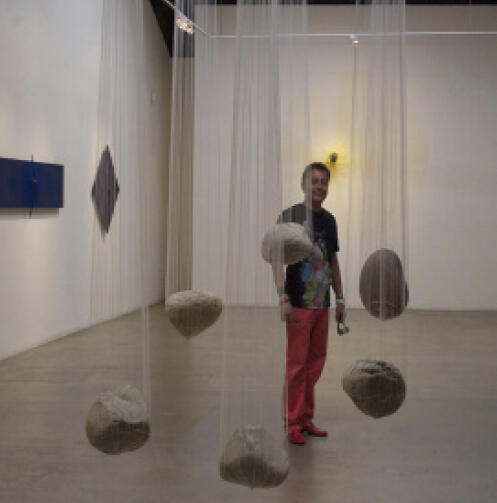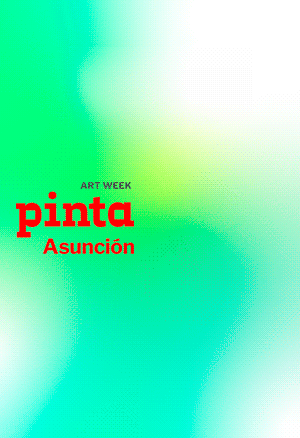Milton Becerra
Archaeology of the Visible - Invisible
Many times − and this occurs in the visual arts − we are presented with a complex narrative, occasionally anachronistic, or with a synthesis that verges on minimalism and forces us to imagine that which has not been depicted, or conversely, to depict the unimaginable.

Milton Becerra confronts us with the undecipherable, the occult, the primitive. He resorts to organic and natural elements and materials: stone, pebbles, string, knots and nodules, which he recontextualizes. And he combines them in order to construct, through a very particular language, structures that play with gravity and create a tension between the materials employed. He proposes in his works a balance between contemporary civilization and the most primitive and ancestral elements of human culture. I have been very curious to see, observe and study all our cultural baggage from the past and I have tried to bring all this to the present and express it in a much more contemporary way; I am a kind of vehicle, of link, of liaison with a culture from the past.*
If Milton Becerra’s oeuvre is viewed retrospectively, one discovers in it important variants related to the memory of Pre-Columbian culture, its icons and its myths. Omnipresent in his work, they are addressed through personal readings and approaches in which it may be noticed that he has resorted to different media such as drawing, assemblage, sculpture and installation. As for the materials employed, the constant presence of stone and fiber is distinctive, and so is the recurring utilization of found objects such as small figurines or ceramic fragments. These are objects that have their own memory, that bring with them the existence of a past time, of past experiences and stories, and that, through assemblage and superimposition, are transformed into new pieces, into modern icons. I use stone and I assign it a space within space; I do so through my own vision, the one in which I have been trained, which is a sculptor’s vision; I use many media to express what I do, but essentially I am a sculptor of nature.*
A disciple of Rafael Soto and Cruz Diez, with whom he worked between 1974 and 1980, he is one of the most relevant Venezuelan visual artists in the contemporary art scene. His work is not only included in the coordinates of universal art, but it represents the new languages created by artistic avant-garde movements such as kinetic art, op art, minimalism, land art, and installation. A tireless traveler, Becerra divides his time between Paris, different parts of Venezuela and Miami, and he travels worldwide, collecting stones and objects.
His work is not only form in space but also matter that is highlighted, ennobled and projected. It is a dialogue between associations and opposing characteristics: soft-hard, object-shadow. Sculptures that the artist prefers to call “relationship states”, carefully elaborated, executed slowly and laboriously, in a way that is analogous to the gesture of weaving. With just one look at the exhibition “Ale'ya”, featured at Galerie13 Jeannette Mariani, it is possible to intuit, despite the magnitude of the show and through the way in which the animal hides are presented, that the creation of the space has been based on the artist’s intimate, private gesture; we realize that Becerra’s command of his craft renders the material an obedient instrument in his hands. An organic geometry achieved through meticulous work in which the cutting of these hides becomes also a ritual act. Besides, his work acquires transcendence through its expression and breaks away from the barriers of what is known in order to render its action valid, independently of epochs and of time. I chose hides because they conveyed certain codes I was interested in, as for example, the issues of killing the animal, eating the meat, codes that still exist at present and that cannot be left aside.*
Parallel to his three-dimensional work, he focuses his efforts on the possibilities of photography regarding the study of details in his pieces or in the compositional variants of forms in space, creating a new element of aesthetic production. The same applies to his collages and drawings, which denote a sensibility that relies on narrative, in such a way that they maintain a certain figurative character. In these works, Becerra seeks to suggest a story based on the objects he uses, so that through them, he captures a minimal fraction of time and places us before it for us to complete its mystery, to invent a before and an after. From his naturalist and abstract position, he launches the central mysteries of his artistic discourse.
In addition to reflecting imagination and creativity in the use of recycled elements, Becerra’s works display a significant political content, scientific knowledge and an urgent environmental message. “Mi moneda favorita” and “Cetros de poder” are works which bear a relation to the changes and the political and economic situation in Venezuela. They are a sort of reminder of the past; people have gone back to keeping their money in their homes like their grandparents did. In the 1970s, currency was a good support.* Becerra seeks to incite more questions than answers, a higher plane of contemplation associated to nature, to which he has always turned in search of new bearings and possible evolutionary ways.
Using natural fibers as his favorite material, he creates spectacular installations consisting in “tangles” of threads which, in tension or sometimes as a containing woven network in space, disturb and question − Libélula, 1986, Represa, homenaje a Gego, 1994. Those linen or fiber cords or threads, taken to the periphery of the installations, hold stones or objects that reflect the artist’s personal vision or mythology and his relationship with the cosmos and with infinity. The impression one has when faced with these generally site-specific works is ambivalent. Are they being protected by those threads, as in a cocoon, or on the contrary, are they trapped? Immobilized, present and at the same time inaccessible behind the intercrossing of threads whose density forms a curtain, the stones appear as a metaphor for memory and recollections. These very simple relationships with organic matter afford the work a different transcendence when the spectator beholds it.* It is for this reason that each of the parts that comprise his installations has a precise meaning and an exact connotation that allow us to attend a sort of celebration of nature and of his particular reading of it.
Some reminiscences of a totem and a strong association with ancient myths resonate in these “relationship states,” but each anfractuosity, each crack has bee consciously produced in response to an ethic mandate. Whether he resorts to verticality, horizontality, or the inclusion of color, his works are imbued with an asceticism and a symbolism that perplex us. An artwork makes it possible to invoke and convey certain games that are simple, and people somehow enter that fictitious world. For I believe that in art, there is a part that is fiction and a part that is real. The fictional part is the one that evokes a path in each individual’s imaginative process. Reality is what we constantly experience in our daily life, and today, through the media, we are bombarded with information of what is happening in the world; one must isolate all that reality one perceives and go towards that other reality that every individual seeks within him/herself.*
Becerra’s is a critical oeuvre, inscribed within a poetics that does not yield to cliché or obviate cryptic language when an aesthetic need determines it thus. Milton Becerra’s ability to encode his ideology in symbols, his enormous willingness to work and his aesthetic power permit multiple analogies. Independently of the knowledge they imply, his references to ancient civilizations lead us to make comparisons, to yearn, as always, for the past, and they serve as an aesthetic pretext. His oeuvre forces us to take a clear stand in the here and now. Apparently timeless or linked rather to pre-Hispanic customs that are thought to have disappeared, his installations acquire present-day validity and contemporaneousness.
The powerful content exhibited at a single glance and the simultaneous presence of the remote and the contemporary lead us to remain mute before his works, and it becomes embarrassing not to assign to them a myriad of interpretations, at a time when it seems mandatory to explain everything. Is not the respectful silence that those stones, cords and wood pieces inspire a better response for us to accompany them and internalize them, as is usually done with true art? Becerra’s “relationship states” turn our attention inwards, they make us think and generally intrigue us to the point of despair. They reveal that there is something more than the visible and the transitory.
* Interview with Milton Becerra, by Patricia Avena Navarro, April 2011







